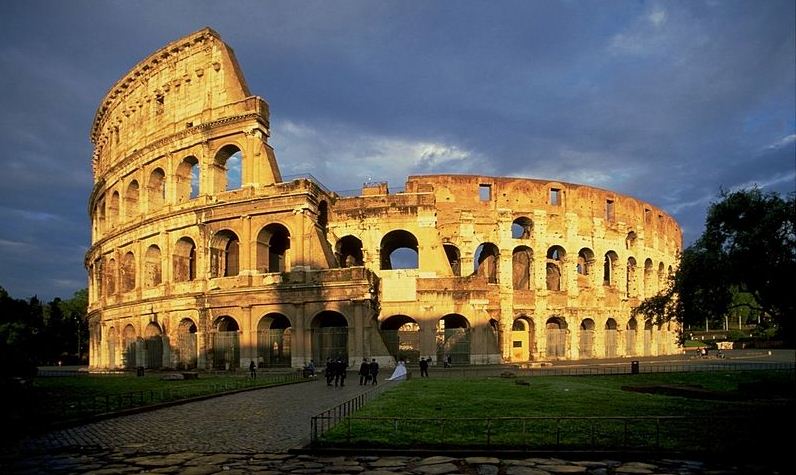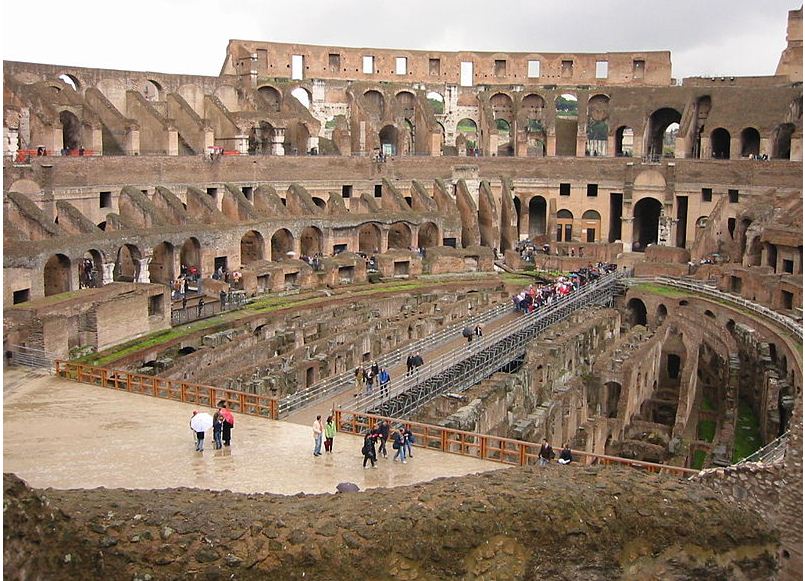Colosseum, the symbol of Roman power and violence, brings back the memories of gladiator fights into our mind. Gladiators were slaves, criminals and prisoners of wars, who were forced to fight each other using various weapons till one became dominant and killed the other. These bloody fights were witnessed and supported by thousands of exciting Roman spectators of various classes. The tunnels and chambers below the arena created special effects with animals rising magically from the underground, adding exciting moments to the fight. In most cases when a gladiator defeated his opponent, the spectators would give him signals to kill or spare the defeated person. The winner was acclaimed by all and probably attained freedom.
Roman Colosseum symbolizes a lifestyle that prevailed in ancient Rome 2000 years ago. It is the largest monument ever built in Rome and is one of the marvelous works that reflects the creative magnificence of Roman arts, architecture and engineering. This elliptical colossal amphitheater had a capacity of about 50,000 spectators. In addition to gladiator fights, this amphitheater was used for animal hunts, mock sea battles, presentation of famous battles and classical mythology dramas.
Location
Colosseum, the icon of imperial Rome, is a UNESCO World Heritage site and one of the New 7 Wonders of the World, situated in the heart of Rome in Italy. It is one of the most frequently visited historical monuments of Rome and is located next to the Roman Forum and Palatine Hill, another two great sites of the city.
History
Emperor Vespasian was the man behind this masterpiece. When Emperor Nero suicided in AD 68, there were successive civil wars for eighteen months, followed by the ascent of Vespasian as the first emperor of Flavian Dynasty. Vespasian decided to build the Roman Colosseum, the master piece of Flavian dynasty on the site of the Golden House of Nero. The construction started in AD 70 and was finished in AD 80, just one year after Vespasian’s death and was opened to the public by his eldest son Titus. Originally known as Flavian Amphitheater, the name Colosseum was derived from a colossal statue (the Colossus) of Emperor Nero that stood on this area.
The fight and blood shed of gladiators and animals that gave violent entertainment to the Romans continued for about 450 years. Christianity spread in Roman Empire and a law was enforced in A.D. 404 by Emperor Honorius to abolish the gladiator fight, but the animal fights continued for another hundred years. With the growth of Christianity, the popularity of the bloody combat and the importance of the Colosseum gradually declined, and the people of Rome gradually relieved from the harsh memories that dominated their city for over 450 years.
Design & Architecture
Colosseum was built with an elliptical shape, 189 meters long and 156 meters wide, with the outer wall of 48 meters tall. It has a perimeter of 545 meters and an area of 24,000 square meters (6 acres). The oval shaped central arena is 87 meters long and 55 meters wide and with a 5 meters high surrounding wall.
The building materials used to build this huge concrete structure were cement, travertine stones, bricks, tile and marbles. High skilled workmanship and standard were accomplished throughout the construction.
Exterior
In the exterior, there were three stories consisting of superimposed arcades and a fourth story having window openings. There were 80 arches in each of the three-tiered stories, with statues in the arches of the second and third floor arcades. There were eighty entrance gates for the spectators, 76 of them for ordinary spectators and the four VIP entrances for emperors and elite persons. On the top of the building was a paneled awning, called Velarium, which served the purpose of a shade to protect the spectators from the intense heat of sun.
Interior Seating
The total capacity of the Colosseum was 50,000, with 45,000 sitting spaces and 5000 standing spaces. Tiered seating arrangements were provided for the different classes of spectators, classified as per their status in the society. The most important persons including emperors, senators, vestal virgins and priests were seated on the first tier called Podium, starting at 4 meters above the arena. Other noble class, including knights, were seated on the second tier known as the ima cavea. Better lower seats of the third tier, or the media cavea, were reserved for ordinary but wealthy Roman citizens and the upper seats of the third tier were reserved for the poor citizens. The fourth tier, the summa cavea, with wooden seats of the gallery running around the theater up to the very top wall, were meant for the common poor, women and slaves.
The Arena
The original floor of the arena was a wooden floor covered by sand with an intricate underground structure, which is known as hypogeum. The hypogeum had two-level concealed tunnels and 32 animal cages. The animals had instant access to the arena through 80 vertical shafts and pulleys. The tunnels provided access to various areas including the training school of gladiators and to the rooms where weapons and equipment were kept. There were several machinery including hydraulic mechanisms that could be used to flood the area quickly for mock navel battles.
Safety
Since the games inside were very dangerous, several protective measures were provided for safety. A huge wall of 15 feet high, faced with marble, were provided to separate the arena from the seating areas, to prevent the violent animals from climbing and reaching the royal people on the podium. A large trench was also provided for more safety.
How to reach there
The Roman Colosseum is situated in the centre of the city. Leonardo da Vinci/Fiumicino International Airport is the main airport of Rome. It is well connected to the center of the city by public transport. Ciampino International Airport, located to the southeast of Rome, is a low-cost airline airport. Colosseum is easily accessible from both the airports using public transport by bus, tram or metro.
When to Visit
Summer season is the best time to visit the Colosseum. During winter, the underground area will be flooded and will make the visit a difficult task. The Colosseum is open for visitors from 8:30 a.m. until one hour before sunset every day, except on Christmas and New Year days. All the three attractions, the Colosseum, the Roman Forum and the Palatine Hill can be visited under a single admission ticket, valid for two days. From 2011 onwards, the underground chambers and the third tier of the Colosseum were also opened to public, which were closed for decades.
Conclusion
Serving as the entertainment centre of Rome for more than 450 years the Colosseum was subject to many repairs and restoration work. Major repairs were carried out when fire struck the higher storeys in 217 AD, and after earthquakes in 443 and 484 AD. Restoration works were carried out to maintain the classic nature of the Colosseum, the recent one being a massive restoration project completed in 2000. A major restoration work is being carried out now, to be completed by 2016. Even today, when fully lit from within the massive structure on a dark Roman night, this great monument will take the visitors back to 2000 years ago and the clashing sounds of the swords of the gladiators will rumble in their ears.
Image source: http://commons.wikimedia.org/wiki/Colosseum

